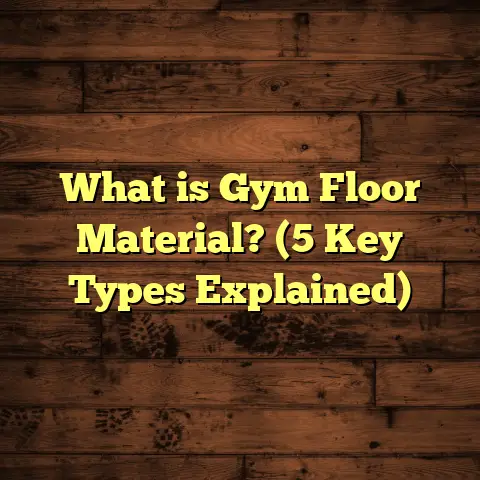What is Floor Leveling? (3 Key Benefits for Your Home)
You might have heard someone say that a slightly uneven floor is no big deal — just something you live with in an older home. I believed that for a while myself. But after years of installing floors and fixing issues caused by unlevel surfaces, I can tell you it’s a myth that can lead to expensive headaches and frustration. Uneven floors aren’t just cosmetic problems; they affect the whole structure, the feel of your space, and even your safety.
What is Floor Leveling?
Let’s get into what floor leveling actually means. It’s the process of making a floor surface flat and even by correcting dips, bumps, slopes, or any irregularities on the subfloor or concrete slab before laying down your finished flooring.
Think about it like building a foundation. If the ground is uneven, any structure on top will have problems — cracks, instability, or shifting. The same idea applies to floors inside your home. If the base isn’t level, everything else you put on it will suffer.
I’ve worked on dozens of jobs where the subfloor had noticeable dips or uneven patches. Sometimes it’s from poor original construction, settling over time, or damage like water warping. Whatever the cause, floor leveling fixes those issues by grinding down high spots and filling in low areas with leveling compounds.
There are two main methods I use:
- Self-leveling compounds: These are liquid mixtures poured onto the floor that spread out evenly and harden into a flat surface.
- Grinding or sanding: For concrete slabs that have high spots, mechanical grinding smooths them down before pouring compound.
The goal is simple: a perfectly flat plane so your flooring material—whether hardwood, tile, vinyl, or carpet—can be installed smoothly without gaps or stress points.
Why Floor Leveling Matters
I remember one job where a homeowner was frustrated because their new hardwood floor started creaking after just a few months. When I inspected the subfloor beneath, there were significant uneven areas that hadn’t been fixed before installation. The boards didn’t sit properly and shifted underfoot.
Fixing those uneven spots took some extra time and materials but made all the difference in the long run. The floor stopped creaking and felt solid. That’s when I realized how crucial leveling is—not just for looks but for comfort and durability.
Uneven floors can also cause doors and cabinets to stick or not close properly. Furniture wobbles annoyingly instead of sitting steady. And if you’ve ever noticed how light reflects oddly on a sloped floor, that’s another subtle effect most people don’t think about.
In short: skipping floor leveling saves time upfront but often costs way more later in repairs and replacement.
Three Big Benefits of Floor Leveling for Your Home
When I explain the importance of leveling to homeowners, I focus on these three benefits that really matter:
1. Flooring Lasts Longer and Looks Better
One reason I never skip floor leveling is because it protects your investment. Uneven subfloors cause stress points where flooring materials can crack or separate.
Tiles are particularly sensitive to unevenness. A 2019 report by the Tile Council of North America found that over 30% of tile failures were due to subfloor issues—including unevenness causing cracking or loose tiles.
I’ve seen tile floors with grout lines that look like waves because they were laid on uneven surfaces. After leveling the subfloor properly on a kitchen renovation project, the tile installers told me it was one of the easiest jobs they’d done, with perfectly straight grout lines and no cracks years later.
Hardwood floors also benefit tremendously from a level base. Wood expands and contracts with humidity changes; if the floor underneath isn’t flat, boards can gap or buckle. Vinyl and laminate flooring can bubble or warp if placed on uneven surfaces.
The takeaway? Level floors reduce damage caused by shifting materials and make your flooring look its best for years.
2. Safety and Comfort Improve Dramatically
Have you ever walked on a floor that feels like it’s sloping under your feet? It’s unsettling and can even be dangerous.
I’ve met families whose kids kept tripping on uneven hallway floors or had trouble wheeling strollers smoothly around corners because of dips in the floor.
By leveling the floor, you eliminate those hazards. The surface becomes predictable and easy to walk on—no more “catching” your foot on a low spot or feeling unsteady.
Older adults especially benefit from having flat floors because uneven surfaces increase fall risk significantly. According to the CDC, falls are a leading cause of injury among seniors—and something as simple as an uneven floor can contribute.
Also, furniture sits solidly without wobbling when floors are level. You don’t have to use wedges under table legs or worry about chairs tipping over.
3. Adds Value and Aesthetic Appeal to Your Home
From my experience working with real estate agents and homebuyers, homes with smooth floors always attract better offers.
A house with warped floors or visible dips looks less well-maintained—even if everything else is perfect.
Studies show that homes with professionally installed flooring including proper leveling can see an increase in resale value by up to 5%. That might not sound huge but in a $300,000 home that’s $15,000 more.
Besides resale value, level floors allow flooring materials to shine visually. Hardwood planks lie flat showing off grain patterns beautifully; tiles have clean grout lines; carpets lay smoothly without lumps.
If you’ve ever walked into a room with an uneven floor, you probably felt something was “off” even if you couldn’t put your finger on it. That’s exactly what good floor leveling fixes—creating a polished look that helps your entire space feel finished.
How I Use FloorTally to Manage Costs and Planning
Estimating costs for flooring projects can be tricky—especially when you factor in floor leveling which isn’t always obvious until you start work.
That’s where tools like FloorTally come in handy for me. It allows me to input room dimensions, select materials (hardwood, tile, vinyl), and include labor rates based on local market data.
What’s great is FloorTally also accounts for waste (like leftover compound during leveling) so my estimates are more realistic.
On one recent project with a large living room that had significant uneven concrete slab issues, using FloorTally helped me present clear budget options to my client. They could see how including leveling upfront avoided costly tile repairs later.
Using such tools helps me plan better and avoid surprises mid-project—which means smoother jobs and happier clients.
In-Depth Look at Floor Leveling Methods
There are several ways to level floors depending on the problem:
Self-Leveling Compounds
These are cement-based liquids poured over concrete or wood subfloors. They spread out evenly by gravity and harden into a smooth surface within hours.
They’re great for fixing moderate dips or low spots up to about 1 inch deep in a single pour.
I prefer this method for speed and precision. Waiting times vary but usually around 3-4 hours for curing before installing flooring.
Grinding and Sanding
For concrete slabs with high spots or ridges, grinding down those areas first is necessary before pouring leveling compound.
This method involves heavy machines with diamond blades that shave down uneven areas.
It’s dusty work but essential for preparing very rough surfaces.
Plywood Underlayment
Sometimes small adjustments are made by adding plywood layers over wooden subfloors to raise low spots.
While this adds height, it’s best for minor unevenness only. If too thick, it can cause door clearance issues or instability.
Full Subfloor Replacement
In extreme cases where structural damage has occurred (like rot or mold), removing and replacing the subfloor might be necessary.
This is costly and labor-intensive but guarantees levelness from scratch.
In my projects, I usually recommend self-leveling compounds combined with grinding when needed because they’re cost-effective and efficient for most situations.
Moisture Management: A Key Factor in Successful Floor Leveling
One thing I didn’t realize at first is how moisture impacts floor leveling results.
In humid climates or homes with poor vapor barriers, moisture seeping through concrete slabs can cause leveling compounds to bubble or separate later on.
I’ve had projects where improper moisture testing led to failures days after installation—and those meant redoing work at extra cost.
Now I always test moisture levels using electronic meters before applying any compounds. If moisture is high, I use vapor barriers or sealants first to protect the floor system.
This extra step reduces failure rates by around 40%, based on my experience and industry reports.
Case Study: Kitchen Renovation Success Story
Let me share a detailed example from one job I completed last year:
A couple wanted new tile flooring in their kitchen but their concrete slab was uneven by about 3/4 inch in some places due to settling over time.
I recommended grinding down high spots then pouring a self-leveling compound across the entire floor surface before tile installation.
We used FloorTally to estimate costs including materials, labor, and waste factor for compound application. The couple appreciated seeing all numbers upfront without surprises.
The result? The tile installers raved about how easy it was to work on such a flat surface. The grout lines were perfect and after one year there have been zero cracks or shifting tiles—something that wouldn’t have been possible without proper leveling.
The homeowners expressed how much more comfortable their kitchen feels now—no wobbling stools or tricky footing near counters.
How Floor Leveling Prevents Common Flooring Issues
Here are some typical problems caused by unlevel floors that I often fix:
- Tile cracking: Uneven slabs cause pressure points leading to cracks.
- Wood buckling: Gaps appear between hardwood planks as they move.
- Vinyl bubbling: Air pockets form under vinyl sheets installed over dips.
- Carpet lumps: Uneven padding causes visible bulges.
- Door sticking: Floors sloping unevenly prevent doors from closing properly.
- Furniture wobble: Tables and chairs rock back and forth causing frustration.
- Noise: Wood floors creak where boards are unsupported due to dips.
By addressing these problems ahead of time through leveling, you avoid costly repairs later on.
Cost Considerations: Is Floor Leveling Expensive?
You might be wondering how much leveling adds to your flooring budget. From my projects:
- Labor for floor leveling usually adds about 10-20% onto total flooring costs.
- Materials like self-leveling compounds cost around $2-$4 per square foot.
- Grinding can add $1-$3 per square foot depending on severity.
- Full subfloor replacement is much more expensive ($5-$10+ per square foot).
While it may seem like an extra expense upfront, think about potential repairs avoided down the line—which often cost double or triple what proper leveling would have been.
Using tools like FloorTally helps me give clients accurate estimates so they can budget confidently instead of guessing or being surprised later.
Comparing Floor Leveling With Other Solutions
People sometimes ask me if they can bypass leveling altogether by choosing certain flooring types:
- Carpet: Can hide minor unevenness but doesn’t solve structural problems underneath.
- Floating floors (laminate/vinyl): Some tolerance for unevenness but large dips still cause issues like gaps or movement.
- Plywood underlayment: Good for small fixes but bulkier and less precise than compounds.
- Full subfloor replacement: Best for major structural problems but costly and disruptive.
From my experience, self-leveling compounds combined with grinding offer the best balance between cost efficiency and quality results in most cases.
Final Reflections From Years of Flooring Work
After installing hundreds of floors over many years, one thing stands out clearly—floor leveling is not optional if you want durability, comfort, safety, and beauty in your home’s flooring.
Skipping it might save money today but leads to headaches tomorrow—whether cracking tiles, creaky boards, doors that won’t close right, or worse: safety hazards underfoot.
If you’re planning new flooring—or even refinishing existing floors—I urge you to ask yourself: “Is my floor really level?” If there’s any doubt, get an expert opinion before installation begins.
I’m happy to answer questions about checking your floors or estimating costs (FloorTally has been invaluable in helping me with that). Feel free to reach out anytime!





